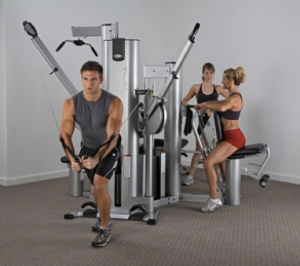One of the most challenging pieces of equipment to evaluate is a cable-system weight machine. There are a lot of numbers associated with the pulley weights, and learning how to evaluate them for your own needs is a crucial skill. Here’s a quick guide for turning all that data into something that makes sense.
Pulley Weights: The Basics
The main number to concentrate on is the ratio. The ratio tells you how the weight is handled when you pull the cable along the pulley system. For example, if you have a standard 200-lb. stack, a 4:1 ratio reduces the actual weight you’re pulling to 50lbs. Similarly, a succession of pulleys in a row can increase that weight pull to 400 lbs. (for leg exercises, for example).
The key here is that a higher ration means the weights are traveling far less, so there’s less movement in the machine. This, in turn, makes the whole operation and use of the machine much smoother, because the stack isn’t moving as much. Think about it: In the 4:1 ratio example above, the weight stack only moves 1 foot for every 4 feet of cable travel.
Weight Increments
The other advantage to a higher ratio is a finer control over weight increments. With a 4:1 ratio, you can achieve 2.5 increments of weight and have much more control over every aspect of your workout. The Vectra VX-FT 1, for example, offers multiple ratios of 2:1, 4:1, and even 6:1 for complete control over your entire workout experience. Many of the machines offered by TuffStuff also offer multiple ratio options.
The upside of a higher ratio is the smoother motion, which can reduce the possibility of injury, reduce vibration and movement of the whole machine (often important in home gyms which are not always sited in ideal locations) and make for a more pleasant workout experience. The downside is that a higher ratio reduces the weight pull and resistance, which can have an adverse effect on your results.
When evaluating weight stack machines for a home gym, the pulley system and the ratio it can offer is one of the most important considerations. Determine whether you need a smoother motion or more resistance and base your purchase on those data points. You’ll end up with exactly the home gym you need.

